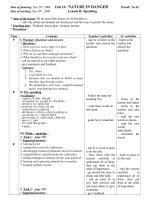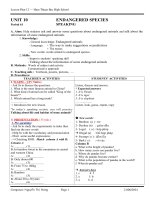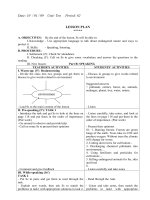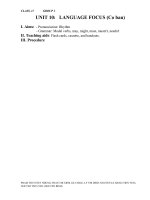Uint 10- Speaking
Bạn đang xem bản rút gọn của tài liệu. Xem và tải ngay bản đầy đủ của tài liệu tại đây (192.27 KB, 3 trang )
Date of planning: Nov 24
th ,
2008 Unit 10 : NATURE IN DANGER Period: No 62
Date of teaching: Dec 30
th
, 2008 Lesson B: Speaking
* Aim s of the lesson : By the end of the lesson, Ss will be able to:
- talk why plants and animals are threatened and the ways to protect the nature.
* Teaching aids : Textbook, lesson plan , pictures, posters.
* Procedures :
Time Contents Teachers activities Ss activities
5
8
8
I. Warmer: Questions and answers
* Q uestions:
1. Have you ever seen a tiger or a lion?
2. Where did you see them?
3. Why do we call them endangered animals?
4. What should we do to protect and save them?
- call on some Ss to give their answers.
- give comments and feedback.
* Answers:
1. Yes, I have.
2. I saw them in a zoo.
3. Because they are hunted or killed so many
that they may become extinct.
4. We should have strict laws, establish national
parks, stop hunting rare animals
II. Pre- speak ing
Vocabulary:
- capture (v):bắt, bắt giữ
- recreation (n): sự giải trí, tiêu khiển
- fertilizer (n): phân bón
- pesticide (n): thuốc trừ sâu
- cultivation (n):canh tác
- discharge (v):đổ ra, chảy ra, phóng ra
- encourage (v) : khuyến khích
- discourage (v) :ngăn chặn, chấm dứt
- ban (v) : cấm
- It is said that people...
- I think
III. While speak ing :
1. Task 1 : page 118
* Suggested answers :
1. burning forest
2. cutting down trees for cultivation.
3. discharging chemical pollutants into environment.
4. using fertilizers and pesticides for cultivation.
5. killing endangered animals for fur, skin and food.
6. hunting and capturing animals for recreation
7. keeping animals as pets.
- ask Ss to listen to the
teacher and answer the
questions.
- Follow the steps for
teaching Voc.
- write these words on
the board:
- guide Ss to remember
- ask Ss to work in pairs
to do the task.
- have them read the
reasons carefully to
understand all of them,
then put them in the
order of importance.
- go around the class to
check and offer help.
- call on some Ss to give
their answers and ask
some others to give
comments.
- give feedback.
- listen to the
teacher and
answer the
questions
- listen to the
teacher and repeat
- listen to the
teacher and take
notes
- read the new
words in chorus.
- read the new
words
individually.
- remember the
words.
- work in pairs to
do the task.
- read the reasons
carefully to
understand all of
them, then put
them in the order
of importance.
8’
8’
7’
1’
2. Task 2 : page 118
* Suggested answers :
Reasons Measures
1. kiling
endangered….
- killing endangered….
- zoos and national
parks…
2. keeping animals… - keeping animals…
3. hunting or capturing
aniamls…
- animals should not be
captured…
4. - burning forests
- cutting down trees
for wood.
- planting trees should be
encouraged.
5. using fertilizer… - decreasing the use…
6. discharging
chemical…
- discharging chemical
pollutants…
3. Task 3 : page 118
Model:
A: It is said that people are killing animals for fur,
skin and food.
B: I think killing animals for fur, skin and food should
be banned.
Sample answer:
A: It is said that people are hunting or capturing
animals for recreation or entertainment.
B: I think animals should not be captured for
recreation and entertainment.
IV. Post – speak ing :
- write a short paragraph about why nature is
threatened and suggest some measures for protecting
environment.
V. Wrapping up
- ask Ss to read the
measures for protecting
the environment in the
box to understand them.
- keep Ss working in
pairs to match the
reasons in Task 1 with
possible measures for
protecting the
environment in the box
- have them to exchange
the answers with another
pair for peer correction.
- call on some Ss to give
their answers
- check the answers with
the whole class.
- give feedback.
- ask Ss to work in pairs
to do the task.
- have them use the
reasons and measures in
task1 and task 2 to do
the task.
- go around the class to
check and offer help.
- call on some pairs to
present their dialogue.
- correct the mistakes
and give feedback.
- ask Ss to do.
*Comments:summarise
the main points of the
lesson.
* Homework:
- leanr the new
words by heart.
- Complete the
writing.
- read the
measures for
protecting the
environment in
the box to
understand them
- match the
reasons in Task 1
with possible
measures for
protecting the
environment in
the box
- work in pairs to
make a dialogue
as the model.
- write it up
- listen to T
- learn and do at
home
V I / Lesson Evaluation:
......................................................................................................................................................
.....................................................................................................................................................
==========*&*==========









